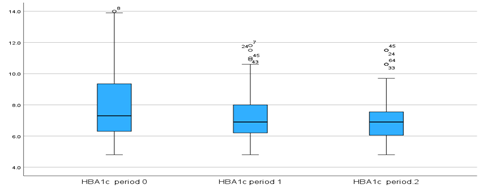Impact of Community Pharmacy-based Primary Care Clinic on the Management of Chronic Diseases in Saudi Arabia
Abstract
 Abstract Views: 0
Abstract Views: 0
In Saudi Arabia, community pharmacies offer individualized, patient-centered care through primary care clinics. To accomplish the healthcare goals set in the country's Vision 2030, this method plays a key role in managing chronic diseases and improving medication management. Hence, this study aims to assess the effectiveness of primary care clinics within community pharmacies in Saudi Arabia, with a focus on their role in delivering personalized, patient-centered care. A chart review approach was utilized in this study conducted at Aldwaa Pharmacy Clinic in Riyadh, Saudi Arabia. The primary objective was to assess the variations in hemoglobin A1C (HbA1c) (%) from baseline. In the same way, the evaluation of blood pressure (BP), body mass index (BMI), fasting glucose (FG), neuropathy, retinopathy, and cardiovascular disease (CVD) symptoms was included as the secondary objective. Measurements were taken at the start and during the two follow-up periods, with patient satisfaction measured after the final visit. It was determined that pharmacist-led interventions significantly dropped HbA1c levels from a median of 7.3% at baseline to 6.9% in both Period 1 and Period 2 follow-ups (p < 0.001). BMI also exhibited significant improvement, dropping from a median of 32.5 kg/m² at baseline to 30.7 kg/m² by the Period 2 follow-up (p = 0.035). Furthermore, patient satisfaction remained notably high, with over 93% reporting being very satisfied with the services. While other secondary outcomes showed improvement, the changes were not statistically significant. The study concluded that community pharmacy-based primary care clinic positively impacts patient health outcomes and patient satisfaction. So, integrating these services into the broader healthcare system is essential to achieve national healthcare goals.
Downloads
References
Gibson H, Sanders C, Blakeman T, Ashcroft DM, Fudge N, Howells K. Providing care to marginalised communities: a qualitative study of community pharmacy teams. Br J Gen Pract. 2024;74(738):e49-e55. https://doi.org/10.3399/BJGP.2023.0422
Eickhoff C, Schulz M. Pharmaceutical care in community pharmacies: practice and research in Germany. Ann Pharmacother. 2006;40(4):729-735. https://doi.org/10.1345/aph.1G458
Farley JF, Blanchard CM, Sorge LA, Rehrauer DJ, Sorensen TD. Implementation outcomes associated with a value-based care model of comprehensive medication management in community pharmacies. J Am Pharm Assoc. 2023;63(3):893-898. https://doi.org/10.1016/j.japh.2022.11.013
Yuan C, Ding Y, Zhou K, Huang Y, Xi X. Clinical outcomes of community pharmacy services: a systematic review and meta-analysis. Health Soc Care Commun. 2019;27(5):e567-e587. https://doi.org/10.1111/hsc.12794
Tsuyuki RT, Al Hamarneh YN, Jones CA, Hemmelgarn BR. The effectiveness of pharmacist interventions on cardiovascular risk: the multicenter randomized controlled RxEACH trial. J Am Coll Cardiol. 2016;67(24):2846-2854. https://doi.org/10.1016/j.jacc.2016.03.528
Sharma S, Kc B, Alrasheedy AA, Kaundinnyayana A, Khanal A. Impact of community pharmacy-based educational intervention on patients with hypertension in Western Nepal. Australas Med J. 2014;7(7):304-313. https://doi.org/10.4066/AMJ.2014.2051
Scott DM, Boyd ST, Stephan M, Augustine SC, Reardon TP. Outcomes of pharmacist-managed diabetes care services in a community health center. Am J Health Syst Pharm. 2006;63(21):2116-2122. https://doi.org/10.2146/ajhp060040
Albabtain B, Cheema E, Bawazeer G, Hadi MA. Community pharmacy-based medication therapy management clinic in Saudi Arabia. In: Babar Z, ed. Pharmacy Practice Research Case Studies. United Kingdom: Churchill Livingstone; 2021:61-68.
Alanazi AS, Alfadl AA, Hussain AS. Pharmaceutical care in the community pharmacies of Saudi Arabia: present status and possibilities for improvement. Saudi Pharm J. 2016;24(5):532-537. https://doi.org/10.1016/j.jsps.2015.02.023
Almanasef M, Almaghaslah D, Kandasamy G, Vasudevan R, Batool S. Involvement of community pharmacists in public health services in Asir Region, Saudi Arabia: a cross-sectional study. Int J Clin Pract. 2021;75(12):e14940. https://doi.org/10.1111/ijcp.14940
Lelie-van der Zande R, Koster ES, Teichert M, Bouvy ML. Barriers and facilitators for providing self-care advice in community pharmacies: a qualitative study. Int J Clin Pharm. 2023;45(3):758-768. https://doi.org/10.1007/s11096-023-01571-3
Alfayoumi I, Henry N, Ieng P, Lee JK. Community-based research: interviewing older people in community pharmacies. Sr Care Pharm. 2023;38(9):378-390. https://doi.org/10.4140/TCP.n.2023.378
Saudi Vision 2030. http://www.vision2030.gov.sa. Updated 2016. Accessed July 25, 2025.
Vision 2030. National Transformation Program 2020. https://www.vision2030.gov.sa/v2030/vrps/ntp/. Updated 2016. Accessed July 25, 2025.
Gupta T, Kolte D, Khera S, et al. Smoker’s paradox in patients with ST-segment elevation myocardial infarction undergoing primary percutaneous coronary intervention. J Am Coll Cardiol. 2017;69(5):611-618. https://doi.org/10.1016/j.jacc.2016.10.083

Copyright (c) 2025 Basmah Albabtain, Lama Altuwijri, Hadeel Almutairi, Mohammed Abdulkarim Alkhars

This work is licensed under a Creative Commons Attribution 4.0 International License.
UMT Journals are dedicated to fostering knowledge sharing, collaboration, and responsible use of published content. To facilitate these principles, UMT Journals publish articles under specific licenses that define how readers, researchers, and the broader community can use, share, and build upon the published work. Authors retain the copyright to their work while granting UMT Journals the right to publish the article under a specified license.









